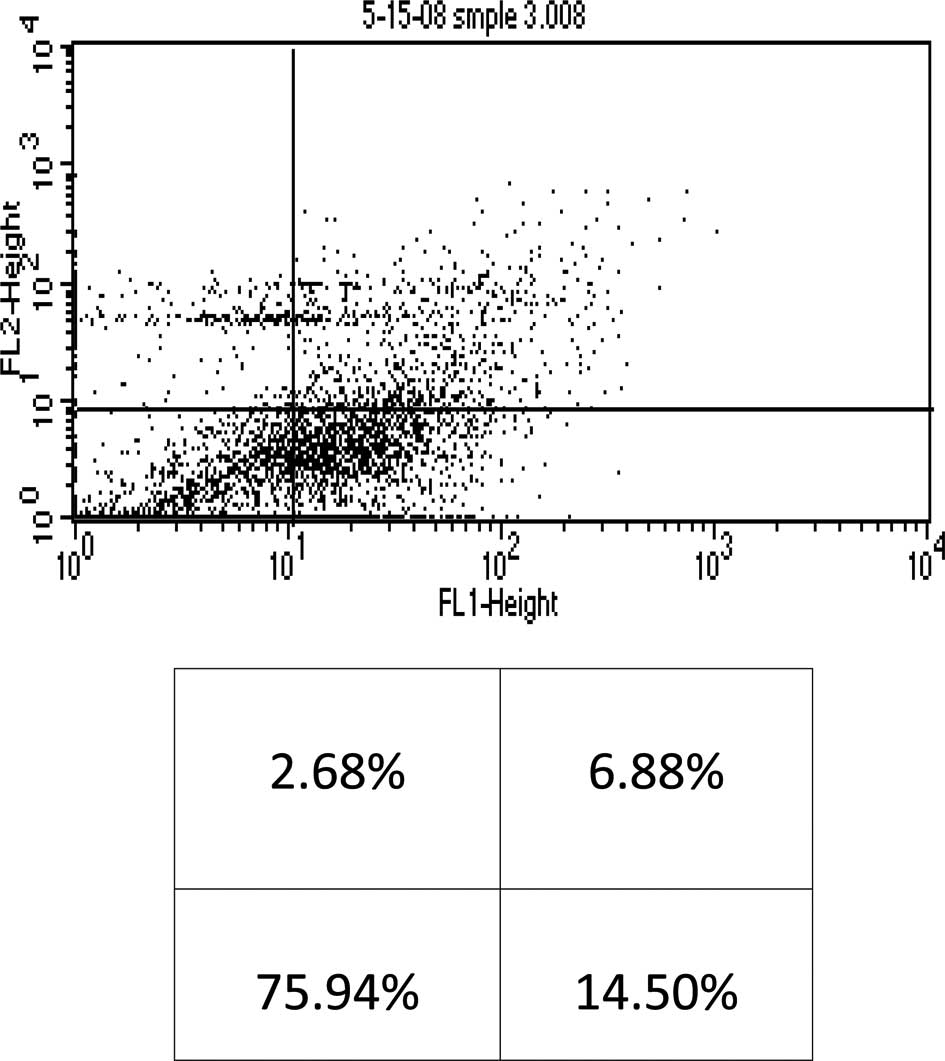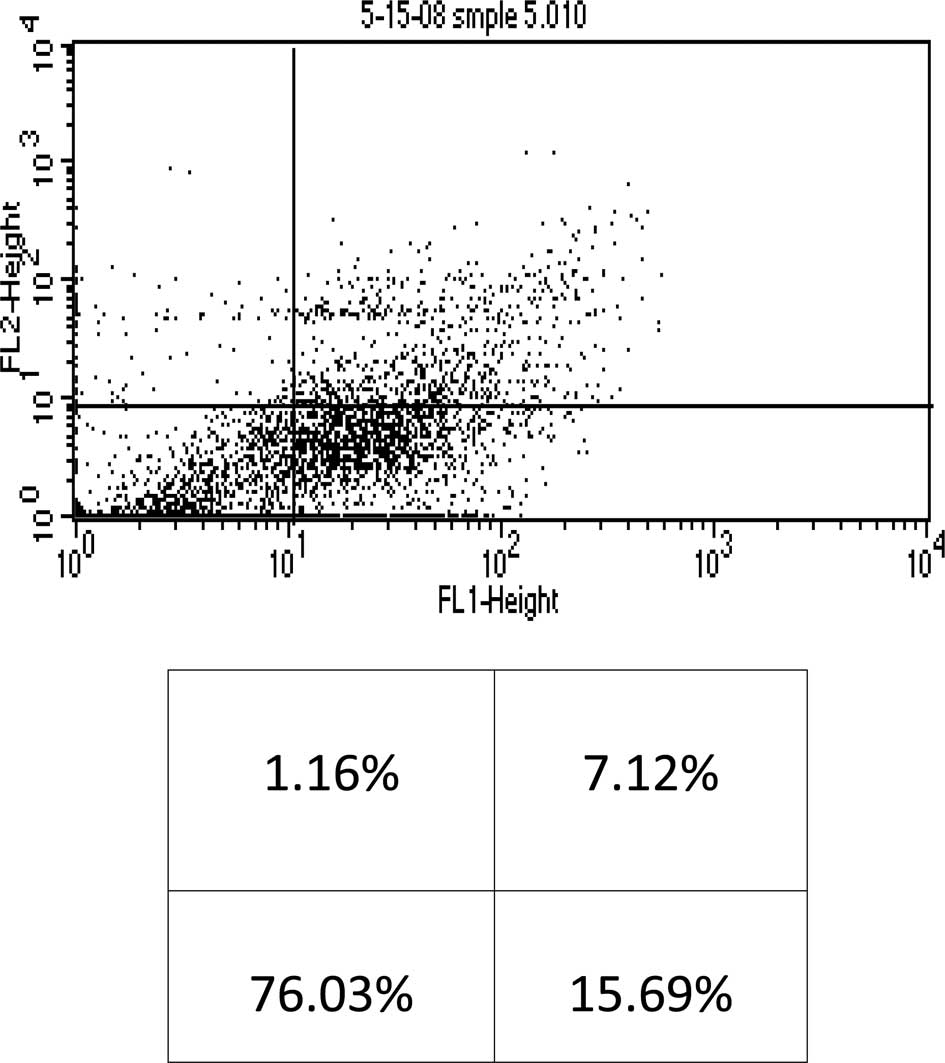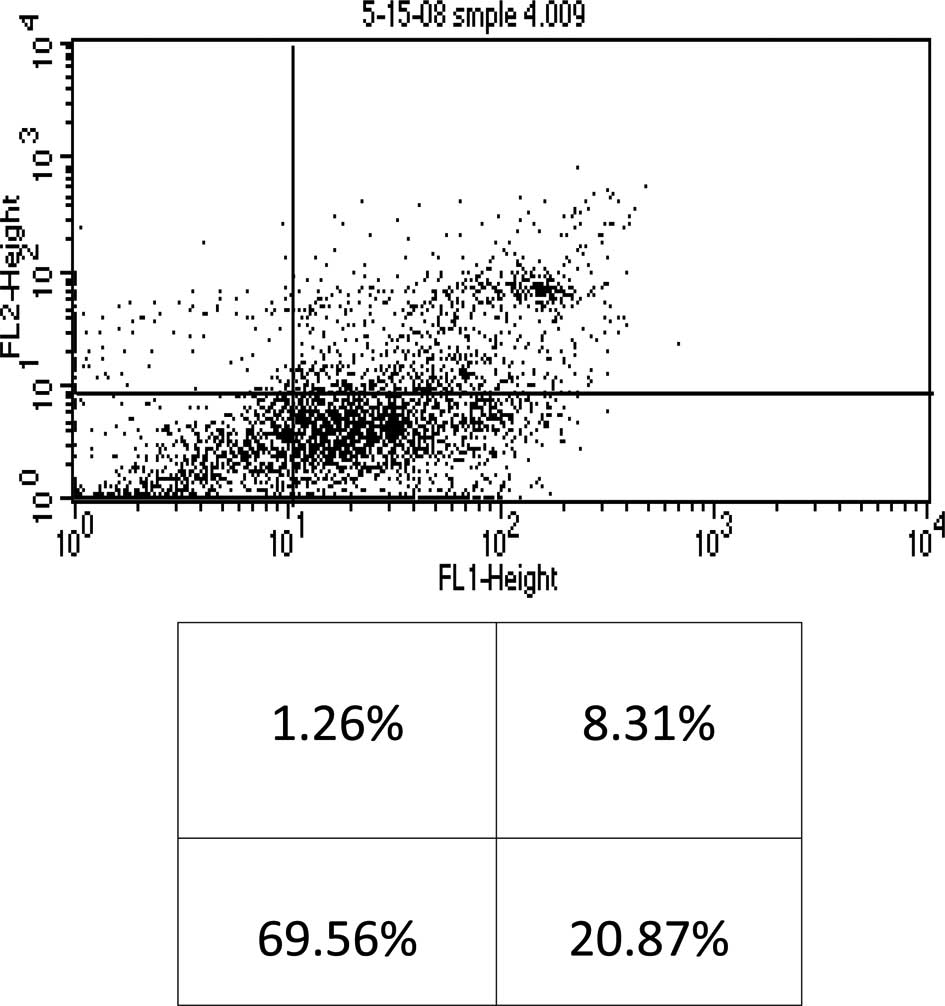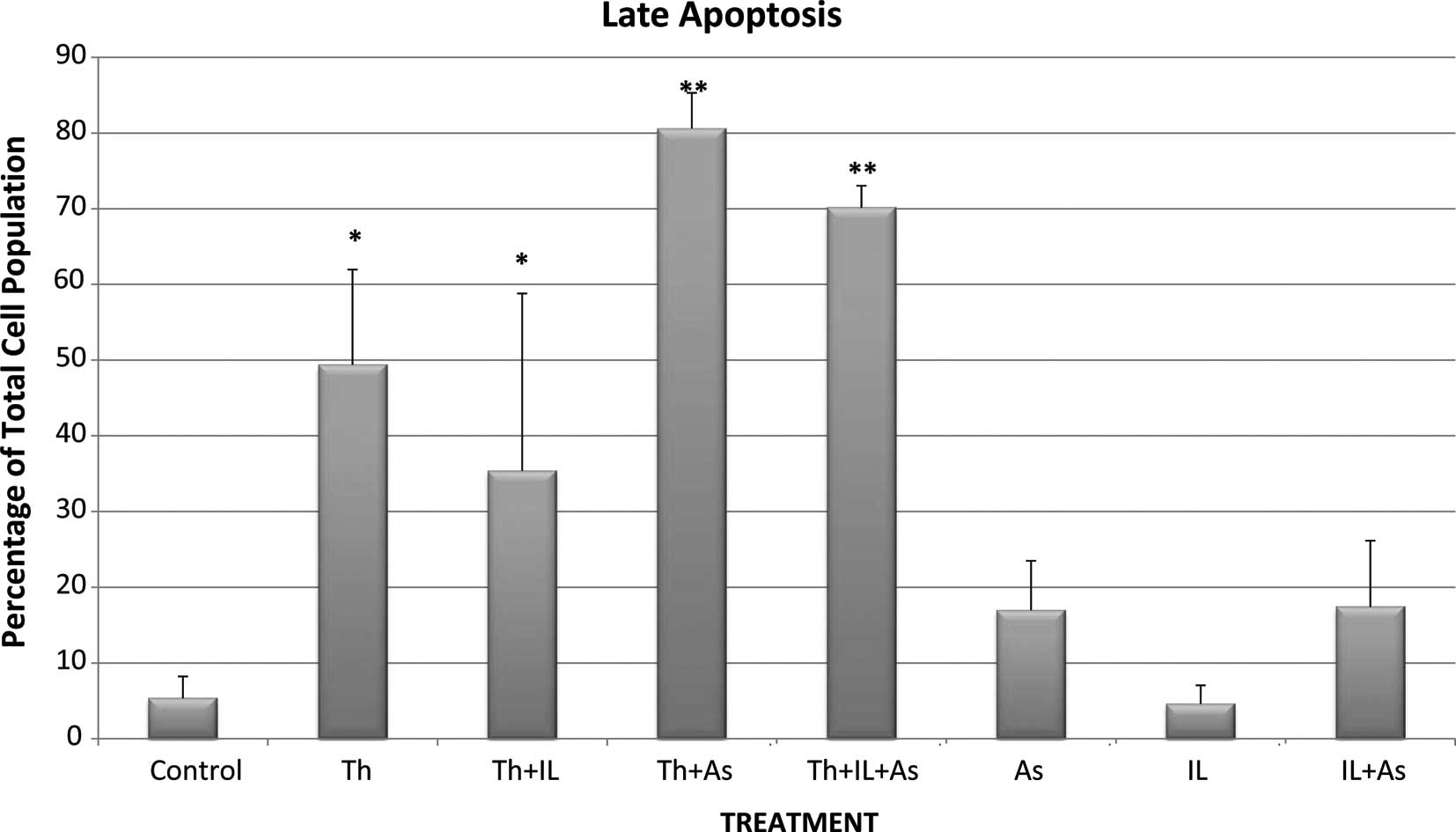|
1
|
Godwin JE and Smith SE: Acute myeloid
leukemia in the older patient. Crit Rev Oncol Hematol. 48:S17–S26.
2003. View Article : Google Scholar : PubMed/NCBI
|
|
2
|
Harousseuau JL: Acute myeloid leukemia in
the elderly. Blood Rev. 12:145–153. 1988. View Article : Google Scholar
|
|
3
|
Cortes JE and Kantarjian HM: Acute
lymphocytic leukemia: A comprehensive review with emphasis on
biology and therapy. Cancer. 76:2393–2417. 1995. View Article : Google Scholar : PubMed/NCBI
|
|
4
|
Estey EH, Kantarjian H and Keating MJ:
Therapy for acute myeloid leukemia. Hematology: Basic Principles
and Practice. 2nd edition. Hoffman R, Benz E Jr, Shattil S, Cohen H
and Silberstein L: Churchill Livingstone; New York: pp. 1014–1028.
1994
|
|
5
|
Thomas DA, Kantarjian H and Smith TL:
Primary refractory and relapsed adult acute lymphoblastic leukemia:
characteristics, treatment results, and prognosis with salvage
therapy. Cancer. 86:1216–1230. 1999. View Article : Google Scholar
|
|
6
|
Beran M, Estey E and O’Brien S: Topotecan
and cytarabine is an active combination regimen in myelodysplastic
syndromes and chronic myelomonocytic leukemia. J Clin Oncol.
17:2819–2830. 1999.PubMed/NCBI
|
|
7
|
Estey EH, Kantarjian HM and O’Brien S:
High remission rate, short remission duration in patients with
refractory anemia with excess blasts (RAEB) in transformation
(RAEB-t) given acute myelogenous leukemia (AML)-type chemotherapy
in combination with granulocyte-CSF (G-CSF). Cytokines Mol Ther.
1:21–28. 1995.PubMed/NCBI
|
|
8
|
Thomas D: Pilot studies of thalidomide in
acute myelogenous leukemia, myelodysplastic syndromes, and
myeloproliferative disorders. Semin Oncol. 37(Suppl 3): 26–34.
2000.
|
|
9
|
Lu C and Hassan HT: Human stem cell
factor-antibody (anti-SCF) enhances chemotherapy cytotoxicity in
human CD34+ resistant myeloid leukemia cells. Leuk Res. 30:296–302.
2006.PubMed/NCBI
|
|
10
|
Yang H, Hoshino K, Sanchez-Gonzalez B,
Kantarjian H and Garcia-Manero G: Antileukemia activity of the
combination of 5-aza-2′-deoxycytidine with valproic acid. Leuk Res.
29:739–748. 2005.PubMed/NCBI
|
|
11
|
Koeffler HP, Billing R, Lusis AJ, Sparkes
R and Golde DW: An undifferentiated variant derived from the human
acute myelogenous leukemia cell line (KG-1). Blood. 56:265–273.
1980.PubMed/NCBI
|
|
12
|
Grad JM, Bahlis NJ, Reis I, Oshiro MM,
Dalton WS and Boise LH: Ascorbic acid enhances arsenic
trioxide-induced cytotoxicity in multiple myeloma cells. Blood.
98:805–813. 2001. View Article : Google Scholar : PubMed/NCBI
|
|
13
|
Block G and Levine M: Vitamin C: a new
look. Ann Intern Med. 114:909–910. 1991. View Article : Google Scholar : PubMed/NCBI
|
|
14
|
Sakagami H and Satoh K: Modulating factors
of radical intensity and cytotoxic activity of ascorbate [review].
Anticancer Res. 17:3513–3520. 1997.PubMed/NCBI
|
|
15
|
Dai J, Weinberg RS, Waxman S and Jing Y:
Malignant cells can be sensitized to undergo growth inhibition and
apoptosis by arsenic trioxide through modulation of the glutathione
redox system. Blood. 93:268–277. 1999.PubMed/NCBI
|
|
16
|
Kruse FF, Joussen AM, Rohrschneider K,
Becker MD and Volcker HE: Thalidomide inhibits corneal angiogenesis
induced by vascular endothelial growth factor. Graefes Arch Clin
Exp Ophthalmol. 236:461–466. 1998. View Article : Google Scholar : PubMed/NCBI
|
|
17
|
Corral LG, Haslett PAJ, Muller GW, et al:
Differential cytokine modulation and T-cell activation by two
distinct classes of thalidomide analogues that are potent
inhibitors of TNF-alpha. J Immunol. 163:380–386. 1999.PubMed/NCBI
|
|
18
|
Haslett PAJ, Corral LG, Albert M and
Kaplan G: Thalidomide costimulates primary human T lymphocytes,
preferentially inducing proliferation, cytokine production, and
cytotoxic responses in the CD8+ subset. J Exp Med.
187:1885–1892. 1998. View Article : Google Scholar
|
|
19
|
Geitz H, Handt S and Zwingenberger K:
Thalidomide selectively modulates the density of cell surface
molecules involved in the adhesion cascade. Immunopharmacology.
31:213–221. 1996. View Article : Google Scholar : PubMed/NCBI
|
|
20
|
Du GJ, Lin HH, Xu QT and Wang MW:
Thalidomide inhibits growth of tumors through COX-2 degradation
independent of antiangiogenesis. Vascul Pharmacol. 43:112–119.
2005. View Article : Google Scholar : PubMed/NCBI
|
|
21
|
Heslop HE, Rooney CM and Brenner MK:
Gene-marking and hemopoietic stem cell transplantation. Blood Rev.
4:220–224. 1995. View Article : Google Scholar : PubMed/NCBI
|
|
22
|
Barret AJ: Mechanisms of the
graft-versus-leukemia reactivity. Bone Marrow Transplant. 1:61–68.
1997.
|
|
23
|
Ball ED, Mills LE, Cornwell GG Jr, Davis
BH, Coughlin CT and Howell AL: Autologous bone marrow
transplantation for acute myeloid leukemia using monoclonal
antibody-purged bone marrow. Blood. 75:1199–1206. 1990.PubMed/NCBI
|
|
24
|
Sznol M and Parkinson DR: Interleukin-2 in
therapy of hematologic malignancies. Blood. 83:2020–2222.
1994.PubMed/NCBI
|
|
25
|
Uckun FM, Kersey JH, Vallera DA, Ledbetter
JA, Weisdorf D and Myers DE: Autologous bone marrow transplantation
in high risk remission T-lineage acute lymphoblastic leukemia using
immunotoxins plus 4-hydroperoxycyclophosphamide for marrow purging.
Blood. 76:1723–1733. 1990.PubMed/NCBI
|
|
26
|
Kalland T, Belfrage H, Bhiladvala P and
Hedlund G: Analysis of the murine lymphokine-activated killer (LAK)
phenomenon: dissection of effectors and progenitors into NK-and
T-like cells. J Immunol. 38:3640–3645. 1987.PubMed/NCBI
|
|
27
|
Ochoa AC, Gromo G, Alter BJ, Sondel PM and
Bach FH: Long-term growth of lymphokine-activated killer
(LAK)-cells: role of anti CD-3, beta-IL 1, interferon-gamma and
-beta. J Immunol. 138:2728–2733. 1987.PubMed/NCBI
|
|
28
|
Peace DJ, Kern DE, Schultz KR, Greenberg
PD and Cheever MA: IL-4-induced lymphokine-activated killer cells.
Lytic activity is mediated by phenotypically distinct natural
killer-like and T-cell-like large granular lymphocytes. J Immunol.
140:3679–3685. 1988.
|
|
29
|
Naume B and Espevik T: Effects of IL-7 and
IL-12 on highly enriched CD56+ natural killer cells: a
comparative study. J Immunol. 147:2208–2214. 1991.PubMed/NCBI
|
|
30
|
Stewart-Akers AM, Cairns JS, Tweardy DJ
and McCarthy SA: Effect of granulocyte macrophage-colony
stimulating factor on lymphokine-activated killer cell induction.
Blood. 81:2672–2678. 1993.PubMed/NCBI
|
|
31
|
Rojas R, Roman J, Herrera C, Alvarez MA,
Ramirez R and Torres A: BALB/C mice injected with LSTRA leukemic
cell line are cured by in vivo treatment with IL-2 + GM-CSF. Leuk
Res. 27:351–357. 2003.PubMed/NCBI
|
|
32
|
Herrera C, Garcia-Perez MJ, Ramirez R,
Martin C, Alvarez MA and Martinez F: Lymphokine-activated killer
(LAK)-cell generation from peripheral blood stem cells by in vitro
incubation with low dose interleukin-2 plus granulocyte
macrophage-colony stimulating factor. Bone Marrow Transplant.
19:545–551. 1997. View Article : Google Scholar
|
|
33
|
Evens AM, Tallman MS and Gartenhaus RB:
The potential of arsenic trioxide in the treatment of malignant
disease: past, present, and future. Leuk Res. 28:891–900. 2004.
View Article : Google Scholar : PubMed/NCBI
|
|
34
|
Lanotte M, Martin-Thouvenin V, Najman S,
Balerini P, Valensi F and Berger R: NB4, a maturation inducible
cell line with t(15;17) marker isolated from a human acute
promyelocytic leukemia (M3). Blood. 77:1080–1086. 1991.PubMed/NCBI
|
|
35
|
Chen GQ, Shi XG, Tang W, et al: Use of
arsenic trioxide in the treatment of acute promyelocytic leukemia
(APL): I. Arsenic trioxide exerts dose-dependent dual effects on
APL cells. Blood. 89:3345–3353. 1997.PubMed/NCBI
|
|
36
|
Park WH, Seol JG, Kim ES, Hyun JM, Jung CW
and Lee CC: Arsenic trioxide-mediated growth inhibition in MC/CAR
myeloma cells via cell cycle arrest in association with induction
of cyclin-dependent kinase inhibitor, p21, and apoptosis. Cancer
Res. 60:3065–3071. 2000.PubMed/NCBI
|
|
37
|
Perkins C, Kim CN, Fang G and Bhalla KN:
Arsenic induces apoptosis of multidrug-resistant human myeloid
leukemia cells that express Bcr-Abl or overexpress MDR, MRP, Bcl-2,
or Bcl-x(L). Blood. 95:1014–1022. 2000.PubMed/NCBI
|
|
38
|
Schor NF, Rudin CM, Hartman AR, Thompson
CB, Tyurina YY and Kagan VE: Cell line dependence of Bcl-2-induced
alteration of glutathione handling. Oncogene. 19:472–476. 2000.
View Article : Google Scholar : PubMed/NCBI
|
|
39
|
Davison K, Mann KK, Waxman S and Miller
WH: JNK activation is a mediator of arsenic trioxide-induced
apoptosis in acute promyelocytic leukemia cells. Blood.
103:3496–3502. 2004. View Article : Google Scholar : PubMed/NCBI
|
|
40
|
Shao W, Fanelli M, Ferrara FF, Riccioni R,
Rosenauer A and Davison K: Arsenic trioxide as an inducer of
apoptosis and loss of PML/RAR alpha protein in acute promyelocytic
leukemia cells. J Natl Cancer Inst. 90:124–133. 1998. View Article : Google Scholar : PubMed/NCBI
|
|
41
|
Kinjo K, Kizaki M, Muto A, Fukuchi Y,
Umezawa A and Yamato K: Arsenic trioxide-induced apoptosis and
differentiation in retinoic acid resistant acute promyelocytic
leukemia model in hGM-CSF-producing transgenic SCID mice. Leukemia.
14:431–438. 2000. View Article : Google Scholar : PubMed/NCBI
|
|
42
|
Rousselot P, Labaume S, Marolleau JP,
Larghero J, Noguera MH and Brouet JC: Arsenic trioxide and
Melarsoprol induce apoptosis in plasma cell lines and in plasma
cells from myeloma patients. Cancer Res. 59:1041–1048.
1999.PubMed/NCBI
|
|
43
|
Liu Q, Hilsenbeck S and Gazitt Y: Arsenic
trioxide-induced apoptosis in myeloma cells: p53-dependent G1 or
G2/M cell cycle arrest, activation of caspase-8 or caspase-9, and
synergy with APO2/TRAIL. Blood. 101:4078–4087. 2003. View Article : Google Scholar : PubMed/NCBI
|
|
44
|
Deaglio S, Canella D, Baj G, Arnulfo A,
Waxman S and Malavasi F: Evidence of an immunologic mechanism
behind the therapeutical effects of arsenic trioxide on myeloma
cells. Leuk Res. 25:227–235. 2001. View Article : Google Scholar : PubMed/NCBI
|
|
45
|
Roboz GJ, Dias S, Lam G, Lane WJ, Soignet
SL and Warrell RP Jr: Arsenic trioxide induces dose-and
time-dependent apoptosis of endothelium and may exert an
antileukemic effect via inhibition of angiogenesis. Blood.
96:1525–1530. 2000.PubMed/NCBI
|
|
46
|
Gartenhaus RB, Prachand SN, Paniaqua M, Li
Y and Gordon LI: Arsenic trioxide cytotoxicity in steroid and
chemotherapy-resistant myeloma cell lines: enhancement of apoptosis
by manipulation of cellular redox state. Clin Cancer Res.
8:666–672. 2002.PubMed/NCBI
|
|
47
|
Kitamura K, Minami Y, Yamamoto K, et al:
Involvement of CD95-independent caspase 8 activation in arsenic
trioxide-induced apoptosis. Leukemia. 14:1743–1750. 2000.
View Article : Google Scholar : PubMed/NCBI
|
|
48
|
Gupta S, Yel L, Kim D, Kim C, Chiplunkar S
and Gollapudi S: Arsenic trioxide induces apoptosis in peripheral
blood T lymphocytes subsets by inducing oxidative stress: a role of
Bcl-2. Mol Cancer Ther. 2:711–719. 2003.PubMed/NCBI
|
















